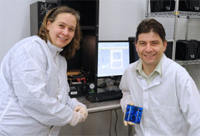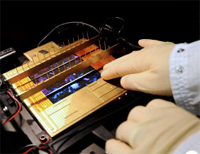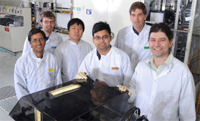January 30, 2010
Q&A with Christiana Honsberg and Stuart Bowden

Honsberg and Bowden in the the Solar Power Lab’s clean room

A newly designed solar cell ready for testing

Bowden with members of the Solar Power Lab research team
Professors Christiana Honsberg and Stuart Bowden are the leaders of ASU’s Solar Power Lab. Honsberg is chief scientist of the lab and is considered a pioneer in photovoltaics. Bowden heads the industrial collaboration section of the lab and is credited with improving the efficiency of silicon and crystalline silicon solar cells and the cell manufacturing process.
At what point did “sustainability” become part of your research focus?
When we became involved in photovoltaic research in the mid-1980s, the quest for solar energy had already been driven up by the 1970s oil crises and then redirected toward space applications as oil prices returned to low levels. Nevertheless, we always expected that when the technology became cheap enough, solar power would provide electricity in underdeveloped countries. The Kyoto Protocol in 1997 became a turning point for us because it highlighted world sustainability issues and prompted many highly developed nations to deploy photovoltaic systems. This has led to increased research focus over the past decade on photovoltaic materials and their impacts.
What are your most important sustainability-related research projects?
In one project, we are working to overcome current barriers to the production of very thin, high efficiency solar cells. Such a breakthrough will stimulate rapid improvements in existing commercial solar cell technology, reduce solar cell costs, and increase their use. Our goal is to put solar cells on a track analogous to what Moore’s Law describes for computers — geometric growth in power over time but at the same cost.
In a second project, we are developing ultra-high efficiency solar cells that will exceed existing efficiency limits of about 30 percent for non-concentrated sunlight and 45 percent for concentrated. Because we are using new approaches, such as exploiting the efficiencies of so-called “intermediate band material,” we expect to dramatically reduce the cost of materials and production while increasing power output. These new cells can literally transform our energy system by opening practical new applications for solar power that range from hydrogen fuel production to “smart windows” — glass that controls the amount of heat transfer in response to conditions.
How will your research affect future policy decisions?
Both of our projects make solar cells better and more affordable, which should increase the ability of policymakers to meet greenhouse gas emission targets. Our ultra-high efficiency solar cells, however, will take us even farther than that. We envision a future in which we no longer plug most of our devices into distant power-generating sources, but instead let them generate and store their own power from available sunlight.
What is the world sustainability challenge that concerns you most?
We are most concerned about the world’s growing need for affordable, sustainable energy. This is a matter of environmental, economic, and social concern for both rich and poor countries.
January 30, 2010

